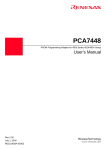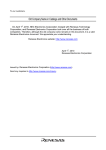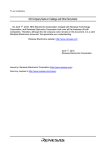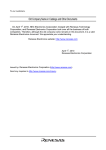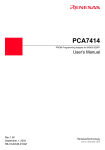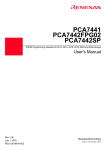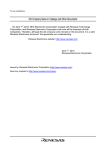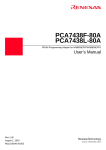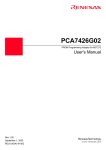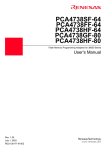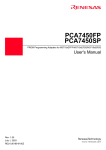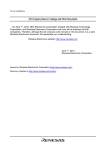Download Renesas PROM Programming Adapter PCA7448 Technical information
Transcript
To our customers, Old Company Name in Catalogs and Other Documents On April 1st, 2010, NEC Electronics Corporation merged with Renesas Technology Corporation, and Renesas Electronics Corporation took over all the business of both companies. Therefore, although the old company name remains in this document, it is a valid Renesas Electronics document. We appreciate your understanding. Renesas Electronics website: http://www.renesas.com April 1st, 2010 Renesas Electronics Corporation Issued by: Renesas Electronics Corporation (http://www.renesas.com) Send any inquiries to http://www.renesas.com/inquiry. Notice 1. 2. 3. 4. 5. 6. 7. All information included in this document is current as of the date this document is issued. Such information, however, is subject to change without any prior notice. Before purchasing or using any Renesas Electronics products listed herein, please confirm the latest product information with a Renesas Electronics sales office. Also, please pay regular and careful attention to additional and different information to be disclosed by Renesas Electronics such as that disclosed through our website. Renesas Electronics does not assume any liability for infringement of patents, copyrights, or other intellectual property rights of third parties by or arising from the use of Renesas Electronics products or technical information described in this document. No license, express, implied or otherwise, is granted hereby under any patents, copyrights or other intellectual property rights of Renesas Electronics or others. You should not alter, modify, copy, or otherwise misappropriate any Renesas Electronics product, whether in whole or in part. Descriptions of circuits, software and other related information in this document are provided only to illustrate the operation of semiconductor products and application examples. You are fully responsible for the incorporation of these circuits, software, and information in the design of your equipment. Renesas Electronics assumes no responsibility for any losses incurred by you or third parties arising from the use of these circuits, software, or information. When exporting the products or technology described in this document, you should comply with the applicable export control laws and regulations and follow the procedures required by such laws and regulations. You should not use Renesas Electronics products or the technology described in this document for any purpose relating to military applications or use by the military, including but not limited to the development of weapons of mass destruction. Renesas Electronics products and technology may not be used for or incorporated into any products or systems whose manufacture, use, or sale is prohibited under any applicable domestic or foreign laws or regulations. Renesas Electronics has used reasonable care in preparing the information included in this document, but Renesas Electronics does not warrant that such information is error free. Renesas Electronics assumes no liability whatsoever for any damages incurred by you resulting from errors in or omissions from the information included herein. Renesas Electronics products are classified according to the following three quality grades: “Standard”, “High Quality”, and “Specific”. The recommended applications for each Renesas Electronics product depends on the product’s quality grade, as indicated below. You must check the quality grade of each Renesas Electronics product before using it in a particular application. You may not use any Renesas Electronics product for any application categorized as “Specific” without the prior written consent of Renesas Electronics. Further, you may not use any Renesas Electronics product for any application for which it is not intended without the prior written consent of Renesas Electronics. Renesas Electronics shall not be in any way liable for any damages or losses incurred by you or third parties arising from the use of any Renesas Electronics product for an application categorized as “Specific” or for which the product is not intended where you have failed to obtain the prior written consent of Renesas Electronics. The quality grade of each Renesas Electronics product is “Standard” unless otherwise expressly specified in a Renesas Electronics data sheets or data books, etc. “Standard”: 8. 9. 10. 11. 12. Computers; office equipment; communications equipment; test and measurement equipment; audio and visual equipment; home electronic appliances; machine tools; personal electronic equipment; and industrial robots. “High Quality”: Transportation equipment (automobiles, trains, ships, etc.); traffic control systems; anti-disaster systems; anticrime systems; safety equipment; and medical equipment not specifically designed for life support. “Specific”: Aircraft; aerospace equipment; submersible repeaters; nuclear reactor control systems; medical equipment or systems for life support (e.g. artificial life support devices or systems), surgical implantations, or healthcare intervention (e.g. excision, etc.), and any other applications or purposes that pose a direct threat to human life. You should use the Renesas Electronics products described in this document within the range specified by Renesas Electronics, especially with respect to the maximum rating, operating supply voltage range, movement power voltage range, heat radiation characteristics, installation and other product characteristics. Renesas Electronics shall have no liability for malfunctions or damages arising out of the use of Renesas Electronics products beyond such specified ranges. Although Renesas Electronics endeavors to improve the quality and reliability of its products, semiconductor products have specific characteristics such as the occurrence of failure at a certain rate and malfunctions under certain use conditions. Further, Renesas Electronics products are not subject to radiation resistance design. Please be sure to implement safety measures to guard them against the possibility of physical injury, and injury or damage caused by fire in the event of the failure of a Renesas Electronics product, such as safety design for hardware and software including but not limited to redundancy, fire control and malfunction prevention, appropriate treatment for aging degradation or any other appropriate measures. Because the evaluation of microcomputer software alone is very difficult, please evaluate the safety of the final products or system manufactured by you. Please contact a Renesas Electronics sales office for details as to environmental matters such as the environmental compatibility of each Renesas Electronics product. Please use Renesas Electronics products in compliance with all applicable laws and regulations that regulate the inclusion or use of controlled substances, including without limitation, the EU RoHS Directive. Renesas Electronics assumes no liability for damages or losses occurring as a result of your noncompliance with applicable laws and regulations. This document may not be reproduced or duplicated, in any form, in whole or in part, without prior written consent of Renesas Electronics. Please contact a Renesas Electronics sales office if you have any questions regarding the information contained in this document or Renesas Electronics products, or if you have any other inquiries. (Note 1) “Renesas Electronics” as used in this document means Renesas Electronics Corporation and also includes its majorityowned subsidiaries. (Note 2) “Renesas Electronics product(s)” means any product developed or manufactured by or for Renesas Electronics. User’s Manual PCA7448 User’s Manual PROM Programming Adapter for 4500 Series 4524/4554 Group Rev.2.00 2004.07 • R4944A, R4945 and R4945A are trademarks of Advantest Corporation. • IC51-824.KS-8095 is a product of Yamaichi Electronics Co., Ltd. Keep safety first in your circuit designs! • Renesas Technology Corporation and Renesas Solutions Corporation put the maximum effort into making semiconductor products better and more reliable, but there is always the possibility that trouble may occur with them. Trouble with semiconductors may lead to personal injury, fire or property damage. Remember to give due consideration to safety when making your circuit designs, with appropriate measures such as (i) placement of substitutive, auxiliary circuits, (ii) use of nonflammable material or (iii) prevention against any malfunction or mishap. Notes regarding these materials • These materials are intended as a reference to assist our customers in the selection of the Renesas Technology product best suited to the customer's application; they do not convey any license under any intellectual property rights, or any other rights, belonging to Renesas Technology Corporation, Renesas Solutions Corporation or a third party. • Renesas Technology Corporation and Renesas Solutions Corporation assume no responsibility for any damage, or infringement of any third-party's rights, originating in the use of any product data, diagrams, charts, programs, algorithms, or circuit application examples contained in these materials. • All information contained in these materials, including product data, diagrams, charts, programs and algorithms represents information on products at the time of publication of these materials, and are subject to change by Renesas Technology Corporation and Renesas Solutions Corporation without notice due to product improvements or other reasons. It is therefore recommended that customers contact Renesas Technology Corporation, Renesas Solutions Corporation or an authorized Renesas Technology product distributor for the latest product information before purchasing a product listed herein. The information described here may contain technical inaccuracies or typographical errors. Renesas Technology Corporation and Renesas Solutions Corporation assume no responsibility for any damage, liability, or other loss rising from these inaccuracies or errors. Please also pay attention to information published by Renesas Technology Corporation and Renesas Solutions Corporation by various means, including the Renesas home page (http://www.renesas.com). • When using any or all of the information contained in these materials, including product data, diagrams, charts, programs, and algorithms, please be sure to evaluate all information as a total system before making a final decision on the applicability of the information and products. Renesas Technology Corporation and Renesas Solutions Corporation assume no responsibility for any damage, liability or other loss resulting from the information contained herein. • Renesas Technology semiconductors are not designed or manufactured for use in a device or system that is used under circumstances in which human life is potentially at stake. Please contact Renesas Technology Corporation, Renesas Solutions Corporation or an authorized Renesas Technology product distributor when considering the use of a product contained herein for any specific purposes, such as apparatus or systems for transportation, vehicular, medical, aerospace, nuclear, or undersea repeater use. • The prior written approval of Renesas Technology Corporation and Renesas Solutions Corporation is necessary to reprint or reproduce in whole or in part these materials. • If these products or technologies are subject to the Japanese export control restrictions, they must be exported under a license from the Japanese government and cannot be imported into a country other than the approved destination. Any diversion or reexport contrary to the export control laws and regulations of Japan and/or the country of destination is prohibited. • Please contact Renesas Technology Corporation or Renesas Solutions Corporation for further details on these materials or the products contained therein. Precautions to be taken when using this product • This product is a development supporting unit for use in your program development and evaluation stages. In mass-producing your program you have finished developing, be sure to make a judgment on your own risk that it can be put to practical use by performing integration test, evaluation, or some experiment else. • In no event shall Renesas Solutions Corporation be liable for any consequence arising from the use of this product. • Renesas Solutions Corporation strives to renovate or provide a workaround for product malfunction at some charge or without charge. However, this does not necessarily mean that Renesas Solutions Corporation guarantees the renovation or the provision under any circumstances. • This product has been developed by assuming its use for program development and evaluation in laboratories. Therefore, it does not fall under the application of Electrical Appliance and Material Safety Law and protection against electromagnetic interference when used in Japan. Renesas Tools Homepage http://www.renesas.com/en/tools ( 2 / 18 ) Contents Chapter 1. Precautions for Safety ........................................................................................... 4 1.1 Safety Symbols and Meanings .............................................................................. 4 Chapter 2. Introduction ........................................................................................................... 6 2.1 Things to Check When Unpacking ....................................................................... 6 Chapter 3. Specifications ........................................................................................................ 7 Chapter 4. How to Write the Program .................................................................................... 8 4.1 Programming Procedure ........................................................................................ 8 4.2 Attaching the Adapter to the PROM Programmer ................................................ 9 4.3 Inserting an MCU into the Adapter ..................................................................... 10 4.4 Precautions When Inserting an MCU into the Adapter ...................................... 10 4.5 Caution to Be Taken for Handling This Product ................................................ 11 Chapter 5. Recommended PROM Programmers .................................................................. 12 Chapter 6. Memory Maps ..................................................................................................... 13 Chapter 7. Troubleshooting .................................................................................................. 14 7.1 Errors That Occur When Writing to PROM ....................................................... 14 7.2 MCUs Do Not Function Normally ...................................................................... 15 7.3 Other Precautions ................................................................................................ 15 7.4 How to Request for Support ................................................................................ 16 To use the product properly Precautions for Safety: • Both in this User's Manual and on the product itself, several icons are used to insure proper handling of this product and also to prevent injuries to you or other persons, or damage to your properties. • The icons' graphic images and meanings are given in "Chapter 1. Precautions for Safety" (page 4). Be sure to read this chapter before using the product. ( 3 / 18 ) Chapter 1. Precautions for Safety In both the user's manual and on the product itself, several icons are used to insure proper handling of this product and also to prevent injuries to you or other persons, or damage to your properties. This chapter describes the precautions which should be taken in order to use this product safely and properly. Be sure to read this chapter before using this product. 1.1 Safety Symbols and Meanings WARNING If the requirements shown in the "WARNING" sentences are ignored, the equipment may cause serious personal injury or death. CAUTION If the requirements shown in the "CAUTION" sentences are ignored, the equipment may malfunction. IMPORTANT It means important information on using this product. In addition to the three above, the following are also used as appropriate. means WARNING or CAUTION. Example: CAUTION AGAINST AN ELECTRIC SHOCK means PROHIBITION. Example: DISASSEMBLY PROHIBITED means A FORCIBLE ACTION. Example: UNPLUG THE POWER CABLE FROM THE RECEPTACLE. The following pages describe the symbols "WARNING", "CAUTION", and "IMPORTANT". ( 4 / 18 ) WARNING Warnings for Use Environment: • This equipment is to be used in an environment with a maximum ambient temperature of 35˚C. Care should be taken that this temperature is not exceeded. • Select the proper programming mode of the PROM programmer. CAUTION Caution to Be Taken for Modifying This Product: • Do not disassemble or modify this product. Disassembling and modifying the product will void your warranty. Cautions to Be Taken for This Product: • Use caution when handling this product. Be careful not to apply a mechanical shock such as falling. • Do not directly touch the connector pins of this product. • Be careful with the static electricity when handling this product and the MCU. Caution for Keeping This Product: • When not using this product for a long time: (1) Attach the connector pins of this product to the conductive sponge. (2) Put it into a conductive polyvinyl, and keep it in the package case shipped from the factory. (3) Store it in the place where humidity and temperature are low and direct sunshine does not strike. (4) When using this product, check the waste of sponge has not adhered to the connector pins. IMPORTANT When Using The Product: • Attach this product to the IC socket on the PROM programmer properly. • Insert the MCU to the IC socket of this product properly. • When inserting and pulling out the MCU, be sure to keep the IC socket side above and horizontal. • Do not use the PROM programmer's device identification code readout function. ( 5 / 18 ) Chapter 2. Introduction This product is a PROM programming adapter for 4500 Series 4524 and 4554 Group MCUs (4-bit MCU). This product is used to write programs into the internal EPROM of MCU with a commercially available PROM programmer. This manual mainly explains specifications of this product and how to operate it. Figure 2.1 shows the external view of the product and its constituent parts. Figure 2.1 External view of the adapter and its constituent parts 2.1 Things to Check When Unpacking This product consists of the parts listed in Table 2.1. When unpacking, check to see that it contains all of the components. Table 2.1 Package components Main unit PCA7448 Interface unit PCA7414B*1 Connector PCA7402D*1 (28-pin) User's manual PCA7448 User's Manual (this manual) PCA7448 User's Manual (Japanese) *1 The PCA7414B and the PC7402D are pre-mounted on the PCA7448. IMPORTANT Note on This Product Package: • If any part is missing or there is any doubt about your product package, contact your local distributor. ( 6 / 18 ) Chapter 3. Specifications Table 3.1 lists specifications of the PCA7448. Table 3.1 Specifications of the PCA7448 Operating clock Power supply PCA7448 (main unit) Board configuration PCA7414B*1 (interface unit) PCA7402D*1 (connector) Internal on-chip oscillator of the MCU Supplied from Vcc of the PROM programmer Board to insert a programmable MCU (IC socket for MCU mounted on it) Interface board (Connected by two rows of standard-pitch 18-pin connectors and two rows of standard-pitch 16-pin connectors to the upper and lower boards) Board to connect to the PROM programmer (Standard-pitch 28-pin pin-header mounted) M34524EDFP Applicable MCUs M34554EDFP IC socket 64-pin 0.8-mm-pitch QFP (64P6N-A) IC51-824.KS-8095 (made by Yamaichi Electronics Co., Ltd.)*2 *1 The PCA7414B and the PC7402D are pre-mounted on the PCA7448. *2 For details on the IC socket (IC51-824.KS-8095), contact Yamaichi Electronics Co., Ltd. ( 7 / 18 ) Chapter 4. How to Write the Program This chapter describes procedures you need to follow to write the program. For details on how to operate the PROM programmer, refer to the user's manual of the PROM programmer. 4.1 Programming Procedure Follow the steps in Figure 4.1 to write the program. (1) Read the program into the PROM programmer. (2) Attach the adapter to the IC socket of the PROM programmer. See "4.2 Attaching the Adapter to the PROM Programmer" (page 9). (3) Insert the MCU into the adapter. See "4.3 Inserting an MCU into the Adapter" (page 10). (4) Check to erase the programming area. Using the PROM programmer's erase check function, check whether data can be written into the MCU's programming area. (5) Write the program into the programming area of the MCU using the PROM programmer. (6) Verify the programming area of the MCU using the PROM programmer to check whether the program has been written into the MCU correctly. Figure 4.1 Programming procedure IMPORTANT Note on Programming by PROM Programmer: • Some PROM programmers perform the steps (4) to (6) automatically. ( 8 / 18 ) 4.2 Attaching the Adapter to the PROM Programmer As shown in Figure 4.2, attach the No. 1 pin of the PCA7402D connector (standard-pitch 28-pin pinheader mounted) to the No. 1 pin of the IC socket of the PROM programmer. Figure 4.2 Attaching the adapter to the PROM programmer CAUTION When Attaching the Adapter to the PROM Programmer: • Be careful when attaching to the PROM programmer because incorrect insertion can cause fatal damage to the MCU. ( 9 / 18 ) 4.3 Inserting an MCU into the Adapter As shown in Figure 4.3, insert the MCU into the IC socket with the No. 1 pin of the MCU matched to the No. 1 pin of the IC socket on the PCA7448. Top view Figure 4.3 Inserting an MCU 4.4 Precautions When Inserting an MCU into the Adapter When opening and closing the IC socket, keep the IC socket side above and horizontal. Figure 4.4 shows the state of opening and closing the IC socket to insert an MCU. Side view Figure 4.4 Opening and closing the IC socket CAUTION When Inserting an MCU into the Adapter: • Be careful when attaching to the PROM programmer because incorrect insertion can cause fatal damage to the MCU. • When opening and closing the IC socket, keep the IC socket side above and horizontal. Otherwise the inside of the IC socket may become damaged and cause an electrical insulation failure. ( 10 / 18 ) 4.5 Caution to Be Taken for Handling This Product When not using this product, attach the connector pins of this product to the conductive sponge as it was shipped from the factory. And keep it in the place where temperature and humidity are low and direct rays do not hit. CAUTION When Handling This Product: • Do not touch the connector in the IC socket and the pins on the PROM programmer connector because dirt may cause an electrical insulation failure. ( 11 / 18 ) Chapter 5. Recommended PROM Programmers The PROM programmers listed in Table 5.1 are recommended for this product. Using the actual products, we have verified that these PROM programmers can be used to write programs without problem. Table 5.1 Recommended PROM programmers Manufacturer Device Programming voltage (Vpp) M5M27C256 mode 12.5 V Type name R4944A Advantest Corporation R4945 R4945A IMPORTANT Notes on PROM Programmers: • Nonconformity occurring by using any other PROM programmers listed in Table 5.1 can not be supported. • For how to operate the PROM programmer and the latest type of PROM programmers, contact the manufacturer to confirm whether it can be used for your product. ( 12 / 18 ) Chapter 6. Memory Maps Figure 6.1 shows memory maps of the MCU and the PROM programmer. PROM programmer (M5M27C256 mode) 0000h *1 Lower 5 bits 3FFFh 4000h MCU (M34524EDFP/M34554EDFP) 0000h Programming area (10 bits x 16 KB) 3FFFh *1 Upper 5 bits 7FFFh *1: This area is fixed to "1" on the PROM programmer. *2: When writing, the lower 5 bits and the upper 5 bits are divided and then written into the MCU. Figure 6.1 Memory maps (M5M27C256 mode) ( 13 / 18 ) Chapter 7. Troubleshooting The table below summarizes errors to be checked carefully before you determine them to be a fault. 7.1 Errors That Occur When Writing to PROM Table 7.1 Errors and checkpoints (when newly purchased) Remedy See page Is the adapter attached to the correct position of the PROM programmer? 9 Is the MCU attached to the correct position? 10 Is the correct device selected? 12 Cause Programming adapter PROM programmer Contact failure The IC socket of the PROM programmer may be stained. The socket needs replacing. - Table 7.2 Errors and checkpoints (previously written normally) Cause Remedy See page Is the adapter attached to the correct position of the PROM programmer? 9 Programming adapter Is the MCU attached to the correct position? 10 Is the correct device selected? 12 PROM programmer Contact failure The IC socket of the PROM programmer may be stained. The socket needs replacing. - The PROM programmer connector (28-pin pin-header) at which the PROM programmer is contacted may be stained. Clean it with alcohol, etc. - ( 14 / 18 ) 7.2 MCUs Do Not Function Normally The program operates normally on the emulator, but when the MCU that has normally been written is attached the same program does not necessarily operate in the same manner. The differences between actual MCUs and the emulator are listed below. (1) About ROM area With the emulator, the area where the program has not been read serves as NOP instruction (00h), but the MCU which has been written by the PROM programmer serves as FFh. Therefore the program happens to appear functioning normally even though it may have gone wild. (2) About the initial value of the register With the emulator, the initial value of the register is set to register Z to display the contents of RAM according to the area for referencing. However, with the actual MCU, the register Z is indefinite after resetting. For this, if the register Z is not set, the contents of RAM may not be read out properly. (3) About oscillations The emulator is operated by the external clock on the MCU board, while the actual MCU is operated by the oscillator on the target system. For this, when the oscillator circuit on the target system does not oscillate properly, the MCU does not function normally. (4) About differences of the characteristics The emulator and the actual MCU may differ in characteristics. Consult the user's manuals of the MCU and the MCU board to check for differences in the characteristics again. 7.3 Other Precautions (1) About the Recommended PROM Programmers As MCUs are not totally equal to EPROM, there are some PROM programmer that can not be used depending on MCU type. The recommended PROM programmers we have verified are listed in this user's manual. We have verified that those PROM programmers can be used to write programs without problem. The other PROM programmers which can set programming area might be used as long as they pass the verification check, however, we do not assure that they work properly. Note: No matter which type of PROM programmer you use, it is necessary to verify completion of programming by executing screening, etc. that are stipulated for each MCU used. (2) About Reading Out of Device Identification Code Please do not use the PROM programmer's device identification code*1 readout function. Using this function may break down the MCU. The device identification code is included in EPROM to indicate the manufacturer code and device code. *1 Depending on PROM programmer manufacturers, this may be referred to by another name (e.g. ID code). ( 15 / 18 ) 7.4 How to Request for Support After checking this manual, fill in the following information and email to your local distributor. For prompt response, please specify the following information: (1) Contact address • Company name • Department • Responsible person • Phone number • Fax number • E-mail address (2) Product information • Name of the programming adapter • Serial number • Date of purchase • Target MCU • Symptoms (Fails blank check/Cannot write a program/Fails verification etc.) • Detailed symptoms • How often does the problem occur? (2 out of 10 etc.) • When did the problem start to occur? (Since purchase/Used to work correctly) • Type name of the PROM programmer (Advantest R4945A etc.) • Specified device when writing to PROM (M27C101 etc.) • Specified programming area when writing to PROM • Switch settings of the adapter when writing to PROM ( 16 / 18 ) PCA7448 User's Manual Rev.2.00 July 1, 2004 REJ10J0254-0200Z COPYRIGHT ©2004 RENESAS TECHNOLOGY CORPORATION AND RENESAS SOLUTIONS CORPORATION ALL RIGHTS RESERVED PCA7448 User’s Manual 1753, Shimonumabe, Nakahara-ku, Kawasaki-shi, Kanagawa 211-8668 Japan REJ10J0254-0200Z




















